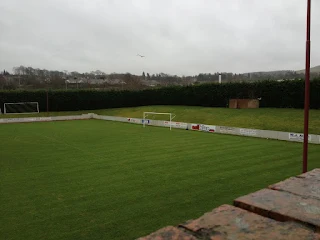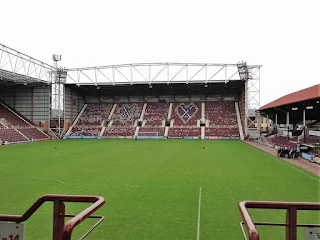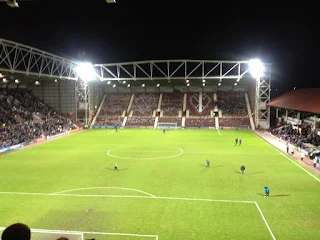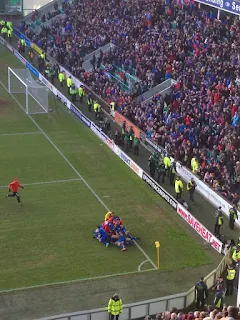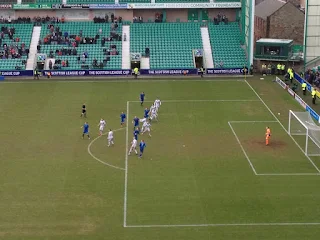Hibernian
FC, or Hibs as they are commonly known, is a professional football club based
in Leith in the north of the Scottish capital of Edinburgh. The club were
formed in 1875 by Irish immigrants in the Cowgate area of the city, with the
name of the club derived from Hibernia, which was the Roman name for Ireland.
Owing to
their background, there was initially some sectarian resistance to Hibs
competing in Scottish football. Despite this, the club lifted the Scottish Cup
in 1886-87 after defeating Dumbarton 2-1 at the second Hampden Park with goals
from Willie Groves and Montgomery.
The team went
on to defeat Preston North End in a game billed as ‘the Association Football
Championship of the World Decider’ before mismanagement left the club homeless
and temporarily ceasing to exist in 1891, before acquiring a new ground named
Easter Road, located on Albion Place, which was opened in 1893.
Hibernian
became members of the Scottish League in 1893-94, winning promotion in 1894-95. At the same time, the club passed a rule that players no longer needed to be
members of the Catholic Young Men's Society. Hibs finished third in their First
Division debut season, which was backed up with a runner-up place the following
season.
In 1895-96, the club were defeated in the only Scottish Cup Final to be played outside
Glasgow, as their arch-rivals Heart of Midlothian triumphed 3-1 at New Logie
Green in Edinburgh. A goal from Andy
McGeachan was enough to beat hosts Celtic to win the 1901-02 Scottish Cup for
the team managed by Dan McMichael. Little did 'Hibees' fans realise that it would
be the last Cup triumph for well over a hundred years.
In 1902-03, the club were crowned as champions of Scotland for the first time as David Reid
topped the scoring chart. The team lost out in the Scottish Cup final in
1913-14, going down 4-1 to Celtic after a replay. There would
be further disappointments in 1922-23 and 1923-24 with final defeats in the Scottish Cup, 1-0 to Celtic and then 2-0 to Airdrieonians, until the team and
club had a succession of seasons without challenging for honours.
However, the
period after World War II would prove to be one of the most successful in the
club’s history as they became one of Britain’s foremost clubs under manager
Hugh Shaw. The 'Famous Five' forward line of Willie Ormond, Bobby Johnstone,
Eddie Turnbull, Gordon Smith and Lawrie Reilly all scored over one hundred
goals for the club.
 |
The old Easter Road Main Stand
|
|
Hibs went
down 2-1 to Aberdeen in the 1946-47 Scottish Cup final as well as ending as league
runners-up, but there was no mistake a year later as the club were crowned league champions, before coming second in 1949-50. The 1950-51
season would see the league crown return to Easter Road, as well as ending as
losing finalists after a 3-0 defeat to Motherwell in the League Cup final.
The
league crown was retained in 1951-52 for a side of which only Ormond cost a
fee, coming in from Stenhousemuir, while the others all came from youth or
junior football. The likes of
Bobby Combe and Eric Younger played valuable parts in the glory years as Hibs ended
as league runners-up in 1952-53 before becoming the first British club to
play in European competition in 1955-56, as Chelsea were deterred from entering
the European Cup.
The Hibees
reached the semi-final stage, where they were defeated by Stade Reims before
going down 1-0 to Clyde in the 1957-58 Scottish Cup final. The club also had
some decent runs in the Inter City Fairs Cup in the 60s with Napoli and
Barcelona amongst their scalps, as Walter Galbraith took over as manager in
1961.
Jock Stein
arrived as manager in March 1964, staying in the post for a year before moving
on to Celtic as he was replaced by Bob Shankly. Third places in Division One in
1967-68 and, along with a 6-2 League Cup final hiding from Celtic in 1968-69, were as good as it got until the appointment of Willie MacFarlane as manager.
His side
finished third in 1969-70 before being replaced by Dave Ewing, who stayed for a
year when former player Eddie Turnbull took up the post in July 1971. His team
would be labelled as 'Turnbull's Tornadoes'.
They lifted
the League Cup in 1971-72 with a 2-1 win against Celtic, which was avenged when
the Celts won the Scottish Cup final 6-1 before Hibs inflicted a 7-0 win over
Hearts in the league at Tynecastle the following year, which can be enjoyed
here. The team went on to finish as league runners-up in 1973-74 and 1974-75.
Peter
Cormack, Peter Marinello, Jimmy O'Rourke, Alex Cropley, John Brownlie and Pat
Stanton, along with the goals of Alan Gordon, were amongst those who starred in
a fine period for the club.
Celtic were
6-3 winners in the 1974-75 League Cup final, before the Premier Division was
introduced in 1975-76, with Hibs finishing third. The poor record in finals
continued as Rangers lifted the Scottish Cup 3-2 in a second replay in 1978-79 against
the team, including Hibernian record league appearance holder Arthur Duncan.
Turnbull was
sacked in April 1980 as the team were eventually relegated despite a few
appearances from George Best, with Willie Ormond having a short spell in charge
before being replaced by Bertie Auld, who led Hibs to the First Division title
at the first time of asking.
Former
playing heroes Pat Stanton from 1982 to 1984 and then John Blackley until 1986
had spells as manager with Hibs, losing 3-0 in the 1985-86 League Cup final to
Aberdeen before Alex Miller arrived in the managerial hot seat in November 1986
at the start of a ten-year tenure.
Performances
gradually improved after a long succession of bottom third finishes, although
the club were found to be performing far worse off the pitch. Hibs were close
to bankruptcy in 1990, at which point Hearts owner Wallace Mercer tried to merge
the two clubs.
 |
Easter Road in 1985
|
The fans set
up a ‘Hands Off Hibs’ campaign, convincing Kwik Fit owner Sir Tom Farmer to buy
a controlling interest in the club despite having no interest in football. In
1991-92, Hibs won the League Cup with a 2-0 win over Dunfermline Athletic with a
side including veteran midfielder Murdo MacLeod.
The team
returned to the final of the same competition in 1993-94, where they went down
2-1 to Rangers. The team finished third in the 1994-95 Premier League season before
Jim Duffy replaced Miller in December 1996, with the goals of Darren Jackson
cheering the Easter Road faithful.
Alex McLeish
was appointed as manager in February 1998, but couldn’t save his side from relegation.
The team returned to the top flight a year later as First Division champions. Kenny
Miller’s goals helped Hibs to third place on their Premier League return.
2000-01 saw
another defeat in the final of the Scottish Cup as Celtic won 3-0, with McLeish
moving to Rangers shortly after to be replaced by popular former player Franck
Sauzée. His disastrous three-month spell ended when Bobby Williamson was
brought in. While the
new man was unpopular with fans, youngsters such as Derek Riordan, Scott Brown,
Kevin Thomson, and Garry O'Connor got their opportunity in the team.
Hibernian
went down 2-0 to Livingston in the 2003-04 League Cup final before the
appointment of manager Tony Mowbray. The former
Middlesbrough player was popular with the style of play he employed as he led
the side to third place in 2004-05 before heading off to West Bromwich Albion
in October 2006, when he was replaced by John Collins.
Collins’
side thumped Kilmarnock 5-1 with goals from Rob Jones, along with pairs from Abdessalam
Benjelloun and Steven Fletcher, to lift the 2006-07 League Cup before he
resigned owing to a lack of funds to strengthen the side. Mixu Paatelainen
arrived as his replacement before he was replaced by John Hughes in June 2009.
He was given
funds to buy Liam Miller and Anthony Stokes as the team qualified for the
Europa League for the 2010-11 season. However, after a poor start and a first-round elimination, Hughes was sacked to be replaced by Colin Calderwood, who
himself lasted just over a year in the hot seat.
Pat Fenlon
was recruited from the Irish side Bohemian in November 2011. Hibs managed to avoid
relegation at the end of the season and also reached the 2011-12 Scottish Cup final,
where their hoodoo continued following a 5-1 defeat to Hearts. Fenlon went
about rebuilding his side in readiness for the 2012-13 season.
Hibs reached
the Scottish Cup Final in 2012-13, but the long losing run continued as Celtic
defeated them 3-0. Fenlon resigned as manager in November 2013 to be replaced
by Terry Butcher. The appointment turned out to be a disaster. The team
went thirteen games without a win at the end of the 2013-14 season, to
land themselves in the relegation play-off against Hamilton Academical.
Accies
went through after a penalty shoot-out at Easter Road to dump Hibs into the
newly named second-tier Championship. Alan Stubbs
replaced Butcher in the summer of 2014 and was faced with another rebuilding job
with the playing squad. Hibs finished in second place in the 2014-15 season but
lost out in the play-offs to Rangers, to be resigned to another campaign at the
second level of Scottish football.
Hibs reached
the play-offs in 2015-16, defeating Raith Rovers before Falkirk ended any
dreams of promotion. However, their biggest reward came at Hampden when Rangers
were defeated 3-2 as the club lifted the Scottish Cup for the first time since
1902, as two Stokes goals were added to by a David Gray stoppage time winner.
Click here
to see Hibs fans celebrate with their Proclaimers anthem, Sunshine on Leith,
after joyous celebrations and a long pitch invasion. Stubbs' side
also reached the League Cup final, losing 2-1 to Ross County before he departed
to take the Rotherham United job, with Neil Lennon taking his place in June
2016 before the goals of Jason Cummings helped Hibernian to the 2016-17
Championship title.
Hibs
finished fourth on their Premiership return before Lennon departed in January
2019 to be replaced by Paul Heckingbottom, whose side ended fifth in 2018-19 before the appointment of Jack Ross as manager in November 2019. The Hibees
were sitting in fifth place when the 2019-20 season ended early owing to the
outbreak of COVID-19.
It saw Hibs reach the Scottish Cup final, where they lost 1-0 to St. Johnstone. Ross took the side to the League Cup final in 2020-21, going down 2-1 to Celtic before the manager was dismissed. Shaun Maloney had a four-month stint in the hot seat before being replaced by Lee Johnson. He took the team into Europe, but he was shown the door a few games into the 2023-24 campaign.
Nick Montgomery became the Hibees' new manager. Former Cup final hero David Gray replaced him in May 2024, transforming things markedly as Hibernian finished third.
Hibernian FC
will play in the Scottish Premiership in the 2025-26 season.
Tuesday 29th January 2013
I was staying in Edinburgh for a few days' break, to be joined by my Dad on Tuesday evening, which left me to my own devices during the day. Never shy of adventuring and visiting new grounds and clubs, I marked out a plan of attack.
Our hotel near the junction of London Road and Leith Walk was only a fifteen-minute walk away at most, but I started my tour for the day just down the road at Meadowbank Stadium, where Edinburgh City were residing.
I got the occasional view of the stands of the stadium as I walked down London Road, before cutting through several streets and walking up Easter Road itself, and then into Albion Road, which had a fine programme shop which was unfortunately closed. I had been close to attending a Hibs game ten days earlier while up north with my pal Karl.
We were staying in Glasgow, but our first choice of Saturday games was Hibs v Dundee, as Edinburgh was less than an hour on the train. Unfortunately, the threat of snow meant a re-adjustment of our plans, so we ended up having a very enjoyable afternoon at Greenock Morton v Livingston instead.
I more or less gave up gaining access as I got to the locked high gates of Easter Road. None of the corners were open, and there weren't even any large enough gaps to take photos. I was about to give up when I walked to the south end of the stadium and saw some men chatting inside through a small gap in the corner.
Noticing that the padlock was open by the gate, and after wondering whether I'd land in bother, I pulled the gate open and attracted the attention of one of the men. He turned out to be kind, getting on in years, who said it wouldn't be a problem taking some photos and commented on just how many people they met who wanted to do similar.
When I told him I was from Scarborough but lived in London, he seemed happy as he'd experienced holidays in the past by the sea, and his daughter also lived in London. I went up near the corner flag to take in the scene and take some photos of the modern all-seater stadium.
To the goal to my right was the two-tiered South Stand, which housed the away fans. Once, this was an open terrace with views of Arthur's Seat in the distance behind it. The new stand had been put up in the mid-90s, as had the similar Famous Five Stand at the other end. To the left was another two-tiered construction, the West Stand.
Built in 2001 to replace the old stand and paddock, the two sections were divided by a row of corporate boxes. This stand also contained all the players' facilities and the directors' box. Finally, on the far side was The East Stand, which was a large single tier of seats, where once a covered terrace stood.
I said my thank you's, as one of the groundstaff mentioned that it was wise not to ask the same at Tynecastle as they'd lock me in! I went on my way back to Leith Walk and on to my next venue, St Mark's Park, the home of non-league Craigroyston.
Inverness Caledonian Thistle 2 Heart of
Midlothian 2 after extra time – Inverness win 4-2 on penalties (Sunday 2nd February 2014) Scottish League Cup Semi Final (att: 12,762)
Once a month, I had a Sunday off work and
didn’t have to return until 4.15pm on the following Monday. This offered scope to get to
games a bit further away than normal, so I decided it was about time to get
adventurous.
Having accumulated enough Reward Points
with East Coast Trains for a free ride back from Edinburgh to London, I also
booked the 11pm coach for the Saturday night from Victoria to the Scottish
capital. My kind workmate John Yorke took me off early so that I could get to
my departure time, as I must admit to being a little nervous about what to
expect.
Fortunately, the service had lots of space, so I secured a double seat for myself. I took a sleeping tablet and, apart
from a comfort break at Woodhall Services on the M1, I knew very little about
the journey as I drifted in and out of slumber. We arrived at Edinburgh bus
station at 7.30am with the light breaking on a clear, cold and windy morning.
Feeling remarkably good, I set off on a
touristy walk over the North Bridge and then up the Royal Mile up to the
Castle, before heading down into Grassmarket and back round to the new town via
Lothian Road. It was a perfect morning for taking photos, and I felt quite
happy with myself as I entered the cold Standing Order.
I took advantage of
the good value Wetherspoon breakfast menu while watching Sky Sports News and
listening to England’s final debacle on their tour of Australia. The unlimited filter coffee deal kept me going for a while longer while I perused the papers.
With the match kicking off at 12.15 for TV, it was high time to seek refreshment. Although my room wasn’t ready at the York
Lodge B&B on York Place, they kindly allowed me to leave my overnight bag.
Continuing along, I was thinking of bars along Easter Road until I saw two gents
cut down Broughton Street in Hearts scarves towards the Cask & Barrel.
The
pub's website had stated that they opened at 12.30 on a Sunday, but I just had a
hunch that I may have been in luck at one of my favourite pubs. Another fan was outside the shut doors, but
he told me that they were about to open at 11am. The beer was just as good as I remembered
from my visit a year earlier.
The Orkney Best glided down like cream. I was in
a really good mood when I joined the growing crowds along Brunswick Road,
Easter Road and then up Albion Road, where I purchased a good match programme
for £3.
My £20 ticket was for the East Stand. There
was time to grab a pie and head up to the top row before the teams came out in
bright sunshine on Leith. Hearts fans filled the stand I was in as well as half of the main
West Stand and the bottom tier of the South Stand. Around 1,500 Caley fans
occupied the lower tier of the North Stand.
Their support was magnificent, as it
was not possible to get to the game on the day by public transport from the
Highlands. My seat was tremendous with an excellent view of the pitch as well
as glimpses of Arthur's Seat and Salisbury Crags behind the south end. Everyone
at the back decided to stand up, which was a good idea on such a cold day.
The first half got underway with Inverness
the better side. Gradually, the young Jambos side got to grips, aided by the non-stop tackling of Jamie Hamill. Their keeper Jamie MacDonald made a fine save
close to the break when Billy McKay broke through.
The sides had met the
previous season at the same stage and at he same venue. On that occasion, the
Edinburgh side won the game after a penalty shootout. Chances were so few
after forty-five minutes that there was a real possibility of the same result
once again.
I went downstairs at the break to use the
facilities and enjoy another pie and a much-needed Bovril as the cold bit. The
prices were not cheap. It was only ten pence less for my drink than the pie! Hearts returned following the interval
looking good, but Caley went ahead in slightly controversial circumstances.
It
looked like a clearance struck one of their players' hands, but the referee, who
upset the Jambos at regular intervals, said no. The ball was rolled into the
path of Greg Tansey, who nearly tore the net from twenty-five yards on fifty-four minutes. However, the game changed dramatically on
sixty-eight minutes when Caley’s Gary Warren picked up a second yellow card for
bringing down a player on the edge of the box.
The Hearts' fans celebrated as though they had scored. Perhaps they could see into the future, as their side’s
training ground set piece saw Jamie Hamill’s shot deflect past Den Brill in the
Highlander’s net, to cue total mayhem. Two minutes later, Hearts were awarded
another free kick around twenty-five yards out. Hamill stepped up and scored
with a brilliant curling shot. The Caley fans stood silently in disbelief.
They created a couple of chances that were
wasted, before Josh Meekings totally lost his head and brought down a breaking
Hearts man with a premeditated body check. Referee John Beaton showed him a
straight red card. It all looked over for his team.
Hearts were within a minute of reaching the
final, in one of the worst seasons in their history as they struggled for their
very existence. They had a corner but lost the ball. Play switched to
the other end, and after a scramble, the ball broke loose to Nick Ross, who
somehow bundled it into the corner in front of his admiring fans.
A few seconds after the restart, Mr Beaton
blew the final whistle. Hearts players collapsed to the floor in sheer agony.
Their manager, Gary Locke, somehow had to motivate them. Whatever he told them
didn’t work. His tactics were completely wrong, keeping four defenders
against an occasional lone striker. There were too many passes without the wide
men getting to the byline past their defender.
Inverness made nonsense of the
numerical advantage as they created better chances. The game would be decided on penalty
kicks once again, to be taken at our end. Their supporters were not exactly
happy. I learned plenty of phrases as well as the words to “Hearts, Hearts
Glorious Hearts”, which was repeated many times.
Hearts went first, but both sides missed
their openers. I was not alone in sensing it wasn’t going to be Hearts' day. Thistle
did not miss another spot kick, which meant that when Paul McCallum missed, it left
Ross Draper to slot home the winner and send Inverness to their first national
cup final. It took some time to get out of the
stadium. I followed the crowds up Easter Road, forgoing the temptation of the
packed pubs to watch the Ireland v Scotland Six Nations Rugby.
I cut across to
Leith Walk and then to my room for a siesta and shower, before going out to
sample some ales in excellent pubs. I was back home with a large fish and
battered burger supper to watch all the highlights on Sportscene at 10pm. The
game looked just as dramatic on TV, although the two red cards did seem a
little on the harsh side.
Following breakfast the next morning in The
Playfair, I was on the 10.30am train, ready for work that afternoon. It had been
a brilliant brief visit to a magnificent city and one of the best games I’d
seen in ages.
Thursday 29th July 2021
With a couple of days off work, I decided to get out
and about as the Covid restrictions were being gradually lifted and take a
flight to Edinburgh for a day of walking, followed by some beer in quality pubs.
Upon arrival in Athens of the North, I took the Airport
200 bus to the waterfront at Newhaven, followed by a walk through the district
of Leith, which was gradually becoming very trendy and somewhere that could be
interesting for nightlife. It was only natural to visit a big football stadium as part of the day.
Easter Road was all locked up, but I had a good wander around
to get some photos and additional exercise. Once done, I headed past Meadowbank
Stadium, which was in a state of being demolished and rebuilt. Over the road I went through Holyrood Park and climbed
Arthur's Seat. Through a lack of experience, I did it from the north-west. Not
the easiest of climbs, but sheer bloody-mindedness got me to the top.
I
descended to the south-west, getting a wonderful view of the Peffermill complex
as well as Easter Road. I was relieved to clamber down to the other side in
excellent company and have a chat with a friendly stranger who had also managed
to reach the peak. My destination was the Cask and Barrel South Side, where
three pints of perfect ale and a chat with the excellent Polish barman did the job.
He pulled no punches when explaining the rules and
directing punters to a seat. One was unimpressed with his bar stool offering in
the window, so he walked out. He had a fantastic mixed accent after spending
ten years in the city. The location gave me my first look at the south of the
city and the University area, walking to my digs off Leith Walk and adjacent to
the North Stand of Easter Road.
Note to self. Remember, suppers come in huge
portions. I couldn't finish the two battered burgers and chips from the
takeaway on Nicholson Street. After a siesta, I was off to visit a couple of places
recommended by a helpful poster on the Non League Forum. The trendy and
intimate St. Vincent Bar was followed by The Cumberland Bar, where I was
restricted to outside drinking near last orders.
My old favourite, The Cask and Barrel on Broughton
Street, where there was only time for two pints as they were closing for the
night, nearly as early as my eyes. I didn’t take much rocking to get to sleep. The
following morning, I headed home by plane from Glasgow in time for the Hendon v
Arsenal friendly.








